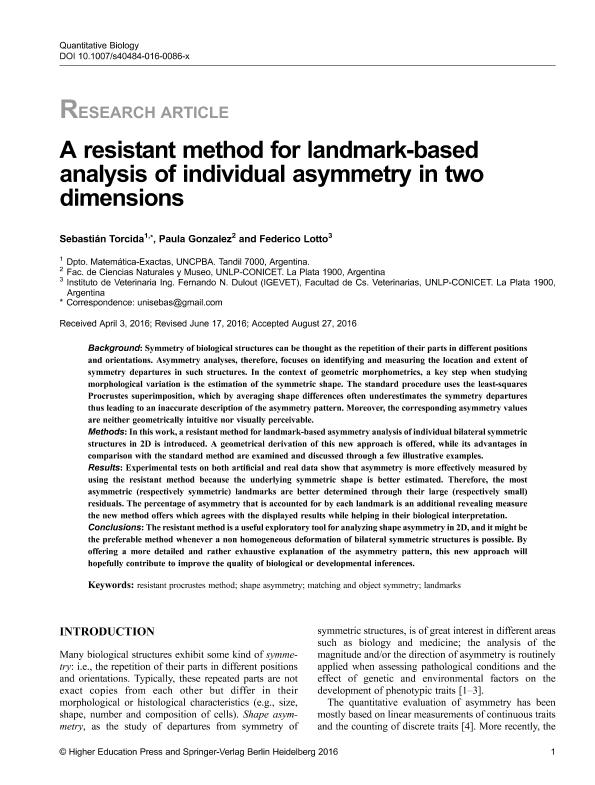Artículo
A resistant method for landmark-based analysis of individual asymmetry in two dimensions
Fecha de publicación:
12/2016
Editorial:
Springer
Revista:
Quantitative Biology
ISSN:
2095-4697
e-ISSN:
2095-4689
Idioma:
Inglés
Tipo de recurso:
Artículo publicado
Clasificación temática:
Resumen
BackgroundSymmetry of biological structures can be thought as the repetition of their parts in different positions and orientations. Asymmetry analyses, therefore, focuses on identifying and measuring the location and extent of symmetry departures in such structures. In the context of geometric morphometrics, a key step when studying morphological variation is the estimation of the symmetric shape. The standard procedure uses the least-squares Procrustes superimposition, which by averaging shape differences often underestimates the symmetry departures thus leading to an inaccurate description of the asymmetry pattern. Moreover, the corresponding asymmetry values are neither geometrically intuitive nor visually perceivable.MethodsIn this work, a resistant method for landmark-based asymmetry analysis of individual bilateral symmetric structures in 2D is introduced. A geometrical derivation of this new approach is offered, while its advantages in comparison with the standard method are examined and discussed through a few illustrative examples.ResultsExperimental tests on both artificial and real data show that asymmetry is more effectively measured by using the resistant method because the underlying symmetric shape is better estimated. Therefore, the most asymmetric (respectively symmetric) landmarks are better determined through their large (respectively small) residuals. The percentage of asymmetry that is accounted for by each landmark is an additional revealing measure the new method offers which agrees with the displayed results while helping in their biological interpretation.ConclusionsThe resistant method is a useful exploratory tool for analyzing shape asymmetry in 2D, and it might be the preferable method whenever a non homogeneous deformation of bilateral symmetric structures is possible. By offering a more detailed and rather exhaustive explanation of the asymmetry pattern, this new approach will hopefully contribute to improve the quality of biological or developmental inferences.
Archivos asociados
Licencia
Identificadores
Colecciones
Articulos(CCT - LA PLATA)
Articulos de CTRO.CIENTIFICO TECNOL.CONICET - LA PLATA
Articulos de CTRO.CIENTIFICO TECNOL.CONICET - LA PLATA
Citación
Torcida, Sebastián; Gonzalez, Paula Natalia; Lotto, Federico Pablo; A resistant method for landmark-based analysis of individual asymmetry in two dimensions; Springer; Quantitative Biology; 4; 4; 12-2016; 270-282
Compartir
Altmétricas




